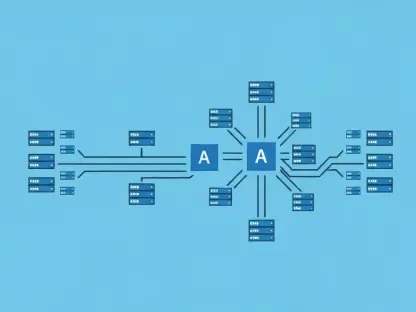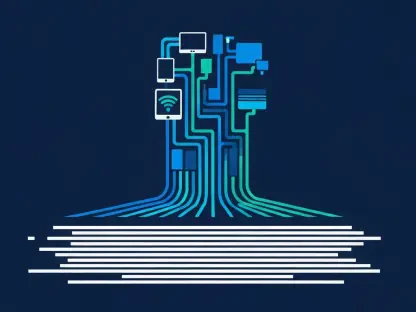In the rapidly evolving field of DevOps, the quest for higher levels of automation and the incorporation of artificial intelligence has become a central focus. As organizations strive to enhance their IT infrastructure and software development practices, several key themes and ongoing challenges have emerged. These trends reflect a broader industry intent on leveraging AI and automation to improve efficiency, security, and overall productivity within DevOps environments.
The Growing Importance of Automation in DevOps
The DevOps community has made significant strides in automating IT infrastructure, yet recent surveys have highlighted persistent gaps. Despite efforts to streamline processes and reduce manual intervention, achieving comprehensive automation remains an elusive goal. This challenge necessitates the development and implementation of new strategies aimed at closing these gaps. By addressing these shortcomings, organizations can ensure more efficient, error-free operations and capitalize on automation’s full spectrum of benefits.
Current State of IT Infrastructure Automation
The journey towards comprehensive IT infrastructure automation in DevOps has been marked by significant advancements. Automation tools are increasingly used to manage complex systems, reduce manual workload, and enhance operational efficiency. However, these advancements often reveal underlying issues that need further resolution. Surveys indicate that while automation tools have streamlined many processes, there are still gaps that prevent the realization of full automation potential. These gaps often arise from the varied complexity of infrastructure requirements across different organizations.
Automation’s progress has been notable in areas such as cloud infrastructure management, deployment pipelines, and configuration management. These areas benefit from decreased human error, faster processing times, and more consistent outcomes. To fully harness these benefits, organizations must continually refine their automation strategies. The focus is on creating more adaptable, resilient systems that can handle the dynamic nature of modern IT environments. As automation technology evolves, the goal is to develop integrated solutions that address these persistent gaps and enhance overall efficiency.
Addressing Automation Shortfalls
The persistent gaps in automation within DevOps contexts underscore the necessity for developing improved solutions. Addressing these shortfalls involves identifying key areas where automation can be more effectively implemented. Organizations are exploring advanced algorithms, machine learning, and artificial intelligence to create robust automation systems. These technologies can help in anticipating issues, optimizing workflows, and providing predictive insights to minimize downtime and enhance efficiency.
Improving automation not only involves technological advances but also necessitates a cultural shift within organizations. Teams must be educated and encouraged to adopt automation tools and practices as integral components of their workflow. This cultural shift makes it vital to invest in training and development programs that enhance skill sets related to automation technologies. By fostering a culture of continuous improvement and innovation, organizations can close the automation gaps and leverage these technologies for maximum benefit.
AI Integration: Transforming DevOps Processes
Artificial intelligence technologies are increasingly becoming integral to DevOps workflows, aiming to enhance a variety of processes. The integration of AI promises transformative changes in how development and operational tasks are executed, improving both efficiency and capability. Examples like Gemini’s Canvas feature illustrate how AI can revolutionize app development by enabling real-time collaboration, code preview capabilities, and seamless prototyping.
Pioneering AI Features and Tools
AI has pioneered a range of features and tools that significantly impact DevOps processes. For instance, Gemini’s Canvas transforms app development workflows through innovative features designed to cater to developers of all skill levels. These features facilitate real-time collaboration, enabling teams to work synchronously on projects regardless of their geographical locations. Additionally, the code preview capabilities allow immediate feedback and adjustments, streamlining the development cycle and reducing the time required for iterations. Seamless prototyping further enhances the process by enabling quick model creation and collaborative refinement before finalizing the product.
The adoption of such AI tools reflects a broader trend toward embracing intelligent systems within DevOps. These tools harness the power of AI to improve efficiency, accuracy, and productivity, making DevOps processes more streamlined and responsive. As AI continues to evolve, its capabilities are expected to expand, offering even more sophisticated solutions that enhance development practices.
Industry-Wide AI Adoption
Industry-wide adoption of AI within DevOps signifies a major shift toward more intelligent, self-learning systems. Major releases like Oracle’s Java 24 emphasize AI integration to improve developer experience and security measures. Java 24’s focus on AI is indicative of a broader trend where AI is leveraged to provide robust security measures, including post-quantum cryptography, which is critical for countering advanced security threats. These advancements underscore the industry’s commitment to adopting AI-driven solutions to address the complex challenges faced by modern DevOps teams.
AI’s integration extends beyond development tools to include other aspects of DevOps, such as monitoring, analysis, and predictive maintenance. AI-powered monitoring systems can analyze vast amounts of data in real-time, providing insights into performance issues, potential downtimes, and optimization opportunities. Such proactive measures allow teams to mitigate issues before they escalate, ensuring smoother operations and higher reliability. The widespread integration of AI across diverse DevOps functions highlights the industry’s dedication to pioneering intelligent solutions that drive innovation and efficiency.
Continuous Delivery and CI/CD Enhancements
Continuous Integration and Continuous Delivery (CI/CD) have long been foundational practices within DevOps, enabling teams to maintain high velocity and quality in their development cycles. Recent developments in CI/CD platforms, particularly open-source solutions, have brought scalable and flexible options to the forefront. These advancements reflect a growing preference for tools that avoid vendor lock-in and promote broader collaboration.
Open-Source Platforms
The open-sourcing of Semaphore’s CI/CD platform under Apache 2.0 represents a significant milestone for DevOps professionals seeking scalable, vendor-lock-in-free solutions. Open-source platforms offer numerous benefits, including flexibility and community-driven development. Semaphore’s open-source model allows developers to customize their CI/CD workflows to fit specific needs, thereby avoiding the constraints typically associated with proprietary solutions. This flexibility is crucial for ensuring seamless integration within diverse environments, supporting continuous improvement and adaptation to emerging technologies.
Additionally, open-source platforms foster a collaborative approach, encouraging contributions from a global developer community. This collaboration leads to the development of innovative features and faster resolution of issues, enhancing the overall utility of the platform. DevOps teams can leverage these community-driven improvements to streamline their workflows, reduce overhead, and maintain high performance and reliability.
Improving DevOps Workflows
Significant strides in enhancing DevOps workflows are evident in tools like GitHub’s improved pull request merge experience. These enhancements aim to streamline workflows, allowing for more efficient software delivery processes. The improved pull request merge experience simplifies code reviews, automates integration processes, and reduces the time required to merge changes, all of which contribute to faster and more reliable delivery cycles. By optimizing these workflows, DevOps teams can maintain a high velocity of development without compromising quality.
Implementing such tools within DevOps practices leads to more cohesive and efficient teamwork. Teams can focus on their core development tasks while relying on streamlined processes to manage integrations and deployments. This focus increases productivity and reduces the likelihood of errors, ultimately resulting in higher-quality software releases. The ongoing improvements in CI/CD platforms underscore the industry’s commitment to enhancing development practices and promoting efficiency.
Elevating Security with DevSecOps
Security within DevOps, often referred to as DevSecOps, remains a critical area of focus. The integration of robust security measures within DevOps workflows is essential to protect sensitive data and maintain system integrity. Incidents like the GitHub Action compromise, which endangered data across thousands of repositories, highlight the ongoing security challenges and underscore the need for proactive and comprehensive security practices.
Addressing Security Vulnerabilities
Addressing security vulnerabilities within DevOps workflows is crucial to mitigating risks and safeguarding systems. The GitHub Action compromise serves as a stark reminder of the potential threats facing DevOps teams. This incident threatened the security of thousands of repositories, illustrating the importance of embedding robust security measures early in the development pipeline. By integrating proactive security mechanisms, teams can preempt threats and minimize the impact of security incidents.
To address these vulnerabilities, organizations are increasingly adopting continuous security practices that involve regular assessments and real-time monitoring. Tools like Static Application Security Testing (SAST) and Software Composition Analysis (SCA) play a vital role in identifying vulnerabilities early and continuously. These tools analyze code and dependencies to detect issues that could potentially compromise security, providing timely feedback and recommendations for remediation.
Integrating Continuous Security Practices
Continuous security practices are becoming essential components of DevSecOps workflows. The integration of SAST and SCA tools within DevOps pipelines helps ensure comprehensive security assessments, addressing vulnerabilities early in the development cycle. By combining these tools, teams can conduct thorough code reviews and dependency analyses, identifying potential security issues before they become problematic.
The continuous nature of these security practices means that assessments and monitoring are ongoing, not just at specific stages of development. This approach ensures that security checks are embedded throughout the pipeline, providing a persistent layer of protection. As security challenges continue to evolve, the integration of continuous security practices enables DevOps teams to adapt and respond proactively, safeguarding their systems and data.
The Role of Cybersecurity in DevOps
The evolving landscape of cybersecurity threats necessitates advanced mechanisms to combat these risks. DevOps teams must continuously adapt their security practices to protect sensitive data and maintain system integrity. Reports on polymorphic extensions, which can morph into any browser extension and threaten data like password managers and digital wallets, highlight the sophisticated nature of modern cybersecurity threats.
Emerging Cybersecurity Threats
Emerging cybersecurity threats require robust and adaptive defense mechanisms. Polymorphic extensions, as reported by companies like SquareX, illustrate the ability of malicious tools to dynamically change their form, making detection and mitigation challenging. These extensions pose significant risks to sensitive data, such as password managers and digital wallets, which are integral to modern digital interactions. DevOps teams must implement advanced security measures capable of detecting and countering these sophisticated threats.
Adapting to these emerging threats involves leveraging AI and machine learning to enhance threat detection and response capabilities. AI-driven security tools can analyze patterns and behaviors to identify anomalies indicative of a cybersecurity threat. By continuously learning and adapting, these tools provide real-time insights into potential risks, enabling timely and effective responses. The dynamic nature of cybersecurity threats necessitates a proactive and adaptable approach, ensuring that DevOps teams remain vigilant and prepared.
AI-Driven Security Training
AI-driven security training programs, like those offered by INE, are critical for equipping DevOps teams with the skills needed to counter emerging threats. These training programs leverage AI to create adaptive learning environments that simulate real-world scenarios, providing practical experiences in threat detection and mitigation. By engaging in such training, DevOps professionals can stay ahead of evolving threats and develop the expertise required to implement robust security measures.
The use of AI in training enhances the learning experience by providing personalized feedback and insights. AI algorithms can analyze individual performance, identify areas for improvement, and tailor training modules to address specific needs. This personalization ensures that each participant receives the most relevant and effective training, ultimately strengthening their security posture. As cybersecurity threats continue to evolve, AI-driven training programs play a vital role in preparing DevOps teams for the challenges ahead.
Unifying DevOps and DataOps
The convergence of DevOps and DataOps is gaining momentum, emphasizing the importance of integrated data management within DevOps workflows. Initiatives like Sawmills’ AI-driven platform for managing telemetry data highlight the need for cost-effective, efficient data handling. This integration aims to unify development, operations, and data management practices, creating more fluid and responsive systems.
Integrating Data Management
Effective data management is crucial in modern DevOps practices, and the convergence with DataOps represents a significant shift toward integrated solutions. Sawmills’ AI-driven platform for managing telemetry data exemplifies this trend by providing tools that streamline data collection, analysis, and utilization. This integration ensures that data handling practices are efficient and cost-effective, reducing overhead and enhancing productivity within DevOps workflows.
DataOps practices focus on improving data quality, governance, and usability, which are essential for informed decision-making. By integrating DataOps into DevOps workflows, organizations can maintain consistent data standards and ensure that data is readily available for analytics and insights. This unified approach enhances the responsiveness of systems, allowing teams to quickly adapt to changes and optimize performance based on real-time data.
Enhancing Efficiency and Responsiveness
In the fast-paced world of DevOps, the push for increased automation and the integration of artificial intelligence (AI) has become a primary focus. Companies are working to improve their IT infrastructure and software development processes, leading to a few key themes and persistent challenges in the field. This industry-wide trend highlights a growing effort to harness AI and automation in order to boost efficiency, enhance security measures, and elevate overall productivity within DevOps environments.
As AI technologies continue to advance, their application in DevOps is seen as vital for maintaining a competitive edge. Automation not only streamlines repetitive tasks but also enables teams to detect and respond to issues promptly, reducing downtime. However, these advancements also bring challenges such as the need for skilled professionals who can manage and optimize AI-driven systems.
Moreover, the integration of AI in DevOps must be carefully balanced to avoid over-reliance, which can lead to vulnerabilities. As organizations navigate these complexities, the goal remains clear: to create a resilient, efficient, and innovative technology landscape.









